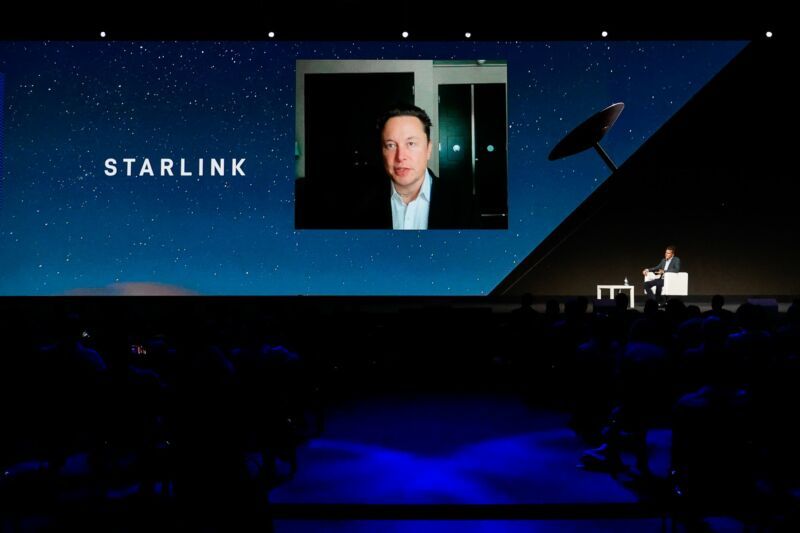Musk expects near-global coverage in August and up to 500,000 users in one year.
SpaceX CEO Elon Musk said his company’s Starlink division is trying to cut the price of its user terminal from $500 to as low as $250. Starlink has been charging $99 a month for Internet service during its beta phase, plus $500 up front for the user terminal/satellite dish, and it’s losing money on the sale of each dish.
“We are losing money on that terminal right now. That terminal costs us more than $1,000,” Musk said yesterday during a Mobile World Congress Q&A session.
“We are subsidizing the cost of the terminal. We are working on next-generation terminals that provide the same level of capability, roughly the same level of capability, but cost a lot less.”
Musk noted that “selling terminals for half price is not super compelling” given that SpaceX is planning for millions of Starlink customers. “Over time, we’d like to reduce the terminal cost from $500 to, I don’t know, $300 or $250, or something like that.”
Musk did not provide any specific timeline for lowering the terminal price. Hopefully, the next terminal will be more tolerant of heat. As we recently reported, the current Starlink dishes go into “thermal shutdown” once they hit 122° Fahrenheit, a limit that caused one Arizona customer to lose Internet service for seven hours and has caused shorter outages for other people.
Starlink hits a “strategically notable” number of users.
Musk rehashed some Starlink plans already made public, such as the company’s expectation that it will push latency below 20 ms. He also updated the current and expected number of users within the following year. “We recently passed the strategically notable number of 69,420 active users,” Musk said. “We are on our way to having a few hundred thousand users, possibly over 500,000, within 12 months.”
Starlink could eventually have a few million home-Internet customers in the US. It has a pending application asking the Federal Communications Commission to let it deploy up to 5 million user terminals in the US, up from its current authorization of 1 million terminals.
Starlink is “operational now in about 12 countries, and more [are] being added every month,” Musk said. So far, Starlink has over 1,500 low-Earth-orbit satellites providing data service capable of a combined 30Tbps, he said. “Starting in August, we should have global connectivity everywhere except the poles,” Musk said.
Starlink no replacement for fiber
Musk has repeatedly said he does not view Starlink as a replacement for fast wireline Internet service. “You can think of Starlink as filling in the gaps between 5G and fiber, and getting to the hardest, most difficult-to-reach 3 percent, possibly 5 percent [of Internet users,” he said yesterday. “It quite nicely complements fiber and 5G.”
SpaceX tells users to expect “brief periods of no connectivity at all” during the beta period. Those outages will presumably become less frequent as more satellites are launched, and the service enters non-beta commercial availability. However, the need for a line-of-sight connection to satellites will continue to make Starlink less reliable than fiber cables.
Musk touted Starlink’s phase-array technology, saying, “To the best of our knowledge, it is the most advanced phase-array system in the world, so that’s pretty cool.” Because of the phase-array antenna technology on the satellites and ground-based terminals, “you can switch from one satellite that’s rushing overhead to another one and do so at the microsecond level,” Musk said. “You can’t tell as the system is switching from one satellite to another. There’s no change in latency or jitter from one satellite to another, and a single satellite can illuminate many different user cell spots on the ground.”
Still, Starlink can’t provide enough capacity to serve a considerable number of customers in high-density areas. Musk has stated that several times, and he said again yesterday, “We’re well-suited to low- and medium-density areas but not high-density areas. In high-density areas, we’ll be able to serve a limited number of customers.”
Musk also recently said that while Starlink should be able to provide service to all 500,000 people who ordered it, getting to several million users will be “more of a challenge.” Musk didn’t say when Starlink will exit beta yesterday, though SpaceX said it would deliver on preorders starting in the second half of 2021.
Cell carriers to use Starlink for backhaul.
Starlink will provide broadband access to users directly and sell network capacity to cellular carriers. Musk said that Starlink has “two quite significant partnerships with major-country telcos that I’d like to be able to announce now, but we defer to our partners to make any announcement” and is “in discussion with several other telcos.” Starlink is attractive to carriers in rural areas where they “might have 5G towers but have trouble with backhaul,” He added that Starlink “can be a very cost-effective way of doing data backhaul.”
Like fiber and cable ISPs, Starlink plans to connect directly to “major server centers,” Musk said. “If someone is using YouTube or Netflix, Google search or Xbox, whatever the case may be, the data flows in the shortest possible [path], thus minimizing latency and jitter,” he said. “Even if big chunks of the Internet go down, you still have connectivity.”
Musk said he expects SpaceX to invest $5 billion to $10 billion in Starlink before it reaches a “fully positive cash flow.” Over a longer time frame, the SpaceX investment could be $20 billion or $30 billion.
“We’ll have to keep investing a great deal after [reaching a profitable state] to not be made irrelevant by continued improvements in cellular” and other satellite systems, he said. Starlink has the most low-Earth-orbit broadband satellites deployed, but it will face competition from OneWeb and Amazon.
